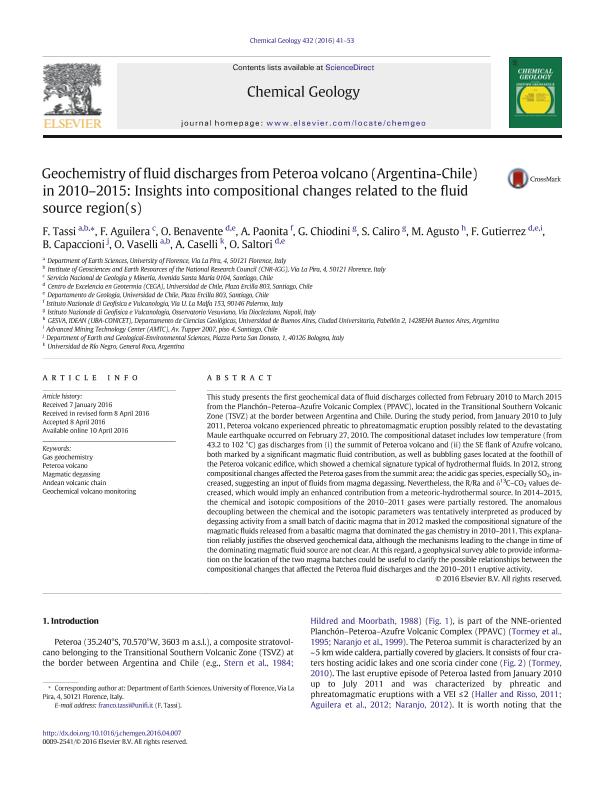Artículo
Geochemistry of fluid discharges from Peteroa volcano (Argentina-Chile) in 2010-2015: Insights into compositional changes related to the fluid source region(s)
Tassi, Franco; Aguilera, F.; Benavente, O.; Paonita, A.; Chiodini, Giovanni; Caliro, S.; Agusto, Mariano Roberto ; Gutierrez, F.; Capaccioni, B.; Vaselli, O.; Caselli, Alberto Tomás
; Gutierrez, F.; Capaccioni, B.; Vaselli, O.; Caselli, Alberto Tomás ; Saltori, O.
; Saltori, O.
 ; Gutierrez, F.; Capaccioni, B.; Vaselli, O.; Caselli, Alberto Tomás
; Gutierrez, F.; Capaccioni, B.; Vaselli, O.; Caselli, Alberto Tomás ; Saltori, O.
; Saltori, O.
Fecha de publicación:
04/2016
Editorial:
Elsevier Science
Revista:
Chemical Geology
ISSN:
0009-2541
Idioma:
Inglés
Tipo de recurso:
Artículo publicado
Clasificación temática:
Resumen
This study presents the first geochemical data of fluid discharges collected from February 2010 to March 2015 from the Planchón–Peteroa–Azufre Volcanic Complex (PPAVC), located in the Transitional Southern Volcanic Zone (TSVZ) at the border between Argentina and Chile. During the study period, from January 2010 to July 2011, Peteroa volcano experienced phreatic to phreatomagmatic eruption possibly related to the devastating Maule earthquake occurred on February 27, 2010. The compositional dataset includes low temperature (from 43.2 to 102 °C) gas discharges from (i) the summit of Peteroa volcano and (ii) the SE flank of Azufre volcano, both marked by a significant magmatic fluid contribution, as well as bubbling gases located at the foothill of the Peteroa volcanic edifice, which showed a chemical signature typical of hydrothermal fluids. In 2012, strong compositional changes affected the Peteroa gases from the summit area: the acidic gas species, especially SO2, increased, suggesting an input of fluids from magma degassing. Nevertheless, the R/Ra and δ13C–CO2 values decreased, which would imply an enhanced contribution from a meteoric-hydrothermal source. In 2014–2015, the chemical and isotopic compositions of the 2010–2011 gases were partially restored. The anomalous decoupling between the chemical and the isotopic parameters was tentatively interpreted as produced by degassing activity from a small batch of dacitic magma that in 2012 masked the compositional signature of the magmatic fluids released from a basaltic magma that dominated the gas chemistry in 2010–2011. This explanation reliably justifies the observed geochemical data, although the mechanisms leading to the change in time of the dominating magmatic fluid source are not clear. At this regard, a geophysical survey able to provide information on the location of the two magma batches could be useful to clarify the possible relationships between the compositional changes that affected the Peteroa fluid discharges and the 2010–2011 eruptive activity.
Palabras clave:
Gas
,
Geochemistry
,
Peteroa
,
Volcano
Archivos asociados
Licencia
Identificadores
Colecciones
Articulos(IDEAN)
Articulos de INSTITUTO DE ESTUDIOS ANDINOS "DON PABLO GROEBER"
Articulos de INSTITUTO DE ESTUDIOS ANDINOS "DON PABLO GROEBER"
Citación
Tassi, Franco; Aguilera, F.; Benavente, O.; Paonita, A.; Chiodini, Giovanni; et al.; Geochemistry of fluid discharges from Peteroa volcano (Argentina-Chile) in 2010-2015: Insights into compositional changes related to the fluid source region(s); Elsevier Science; Chemical Geology; 432; 4-2016; 41-53
Compartir
Altmétricas



